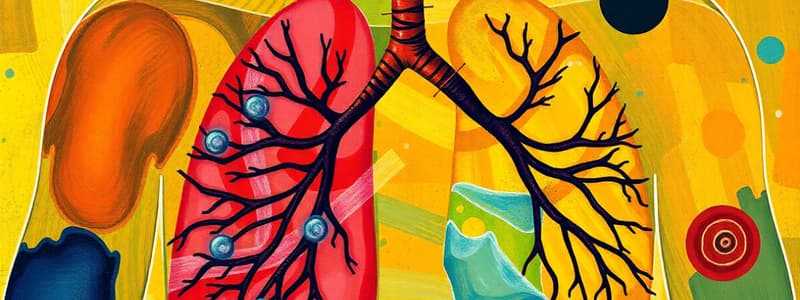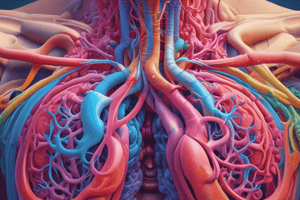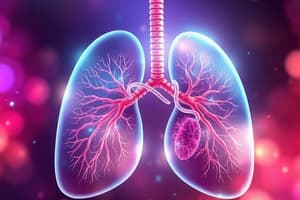Podcast
Questions and Answers
What is the primary function of mucus in the respiratory system?
What is the primary function of mucus in the respiratory system?
- To serve as a lubricant for the bronchi
- To trap and disable inhaled particles and pathogens (correct)
- To promote the growth of cilia
- To facilitate gas exchange in the alveoli
What is the mucociliary escalator?
What is the mucociliary escalator?
- A process that moves mucus towards the pharynx (correct)
- A mechanism for gas exchange in the alveoli
- A method of absorbing nutrients in the bronchi
- A technique for strengthening alveolar walls
Which of the following correctly describes the structure of alveoli?
Which of the following correctly describes the structure of alveoli?
- Hollow tubes lined with ciliated epithelium
- Large air sacs with thick muscular walls
- Flattened spaces with no blood supply
- Small air sacs covered with capillaries (correct)
What role do macrophages play in the alveoli?
What role do macrophages play in the alveoli?
The blood-gas barrier consists of which two systems?
The blood-gas barrier consists of which two systems?
What describes cellular respiration?
What describes cellular respiration?
Which process is NOT part of external respiration?
Which process is NOT part of external respiration?
What is the primary function of the nasal cavity?
What is the primary function of the nasal cavity?
Which component is NOT found in the upper respiratory tract?
Which component is NOT found in the upper respiratory tract?
What characterizes the conducting zone of the airways?
What characterizes the conducting zone of the airways?
What type of tissue structure supports the primary bronchi?
What type of tissue structure supports the primary bronchi?
Which of the following best describes the function of the larynx?
Which of the following best describes the function of the larynx?
How do airways change as they get deeper into the lung?
How do airways change as they get deeper into the lung?
What is the primary role of the conducting airways?
What is the primary role of the conducting airways?
Which of the following statements about the respiratory zone is correct?
Which of the following statements about the respiratory zone is correct?
According to the Weibel model, how many airway divisions comprise the conducting zone?
According to the Weibel model, how many airway divisions comprise the conducting zone?
What happens to inhaled medium-sized dust particles in the terminal bronchioles?
What happens to inhaled medium-sized dust particles in the terminal bronchioles?
How is the temperature of the inhaled air modified by the conducting airways?
How is the temperature of the inhaled air modified by the conducting airways?
What is the main mechanism of air flow in the respiratory zone?
What is the main mechanism of air flow in the respiratory zone?
Which component is NOT involved in the air conditioning process within the conducting airways?
Which component is NOT involved in the air conditioning process within the conducting airways?
What is the typical volume of the conducting airways, which is considered the anatomic dead space?
What is the typical volume of the conducting airways, which is considered the anatomic dead space?
Flashcards
External Respiration
External Respiration
The movement of gases between the environment and the body's cells.
Cellular Respiration
Cellular Respiration
The intracellular reaction of oxygen and glucose to produce carbon dioxide, water, and energy (ATP).
Ventilation/Breathing
Ventilation/Breathing
Air exchange between the atmosphere and lungs.
Gas Exchange (lungs)
Gas Exchange (lungs)
Signup and view all the flashcards
Upper Respiratory Tract
Upper Respiratory Tract
Signup and view all the flashcards
Lower Respiratory Tract
Lower Respiratory Tract
Signup and view all the flashcards
Conducting Zone
Conducting Zone
Signup and view all the flashcards
Terminal Bronchioles
Terminal Bronchioles
Signup and view all the flashcards
Air Filtration
Air Filtration
Signup and view all the flashcards
Mucociliary Escalator
Mucociliary Escalator
Signup and view all the flashcards
Blood-Gas Barrier
Blood-Gas Barrier
Signup and view all the flashcards
Alveoli Function
Alveoli Function
Signup and view all the flashcards
Alveoli Structure
Alveoli Structure
Signup and view all the flashcards
Anatomic Dead Space
Anatomic Dead Space
Signup and view all the flashcards
Respiratory Zone
Respiratory Zone
Signup and view all the flashcards
Terminal Bronchioles
Terminal Bronchioles
Signup and view all the flashcards
Respiratory Bronchioles
Respiratory Bronchioles
Signup and view all the flashcards
Alveolar Ducts
Alveolar Ducts
Signup and view all the flashcards
Acinus
Acinus
Signup and view all the flashcards
Air Warming
Air Warming
Signup and view all the flashcards
Air Moistening
Air Moistening
Signup and view all the flashcards
Study Notes
Respiration
- Respiration can be divided into cellular and external respiration.
- Cellular respiration is the intracellular reaction of oxygen and glucose producing CO2, water, and energy (ATP).
- External respiration involves four processes: ventilation/breathing, gas exchange between lungs and blood, transport, and gas exchange between blood and cells.
The Respiratory Tract
- Divided into upper and lower parts.
- Upper respiratory tract includes the mouth, nasal cavity (air filtration), pharynx (passageway for food and air), and larynx (vocal cords).
- Lower respiratory tract includes the trachea (C-shaped cartilage), primary bronchi (2), bronchial branching, and lungs.
The Airways
- Airways narrow, shorten, and become more numerous as they go deeper into the lungs.
- Divided into conducting and respiratory zones.
- Conducting zone leads inspired air to gas-exchanging regions.
- Conducting airways lack alveoli and do not participate in gas exchange, forming the anatomic dead space (approximately 150ml).
- Respiratory zone is where gas exchange occurs.
- Includes terminal bronchioles branching into respiratory bronchioles, which have occasional alveoli.
- Respiratory bronchioles lead to alveolar ducts, completely lined with alveoli.
Function of Airways (Air Conditioning)
- Passage for air to reach alveoli.
- Air is warmed to 37°C (body temperature) to prevent alveolar damage and avoid core temperature changes.
- Air is moistened to 100% humidity.
- Air is filtered from foreign particles through cilia and mucus.
The Blood-Gas Barrier
- Formed from alveoli and capillaries.
- Respiratory system (alveoli) and circulatory system participate.
- Alveoli are small air sacs covered with capillaries.
- Lack cilia but contain macrophages to engulf particles.
- 300 million alveoli per lung, each about 1/3mm in diameter.
- Each alveolus is made of type I alveolar cells (95% of surface area, very thin for gas diffusion) and type II alveolar cells (5%, secrete surfactant to reduce surface tension).
The Pulmonary Circulation
- Pulmonary circulation starts from the pulmonary artery and ends in the pulmonary vein.
- Low-oxygen blood travels from the right ventricle to the pulmonary arteries.
- Blood passes through pulmonary capillaries and then back to the heart via the pulmonary veins.
- Capillaries form a dense network in the lungs, allowing for efficient gas exchange (0.75 seconds in capillaries per blood cell).
- Pulmonary blood pressure is low (around 15mmHg) due to low resistance in the pulmonary vessels.
Functions of the Respiratory System
- Gas exchange (O2 and CO2).
- Regulates pH.
- Temperature regulation.
- Protection from pathogens.
- Filtration of blood (small thrombi).
- Metabolism (e.g., of Angiotensin).
- Blood reservoir.
- Olfaction (smell).
- Speech generation.
Studying That Suits You
Use AI to generate personalized quizzes and flashcards to suit your learning preferences.




